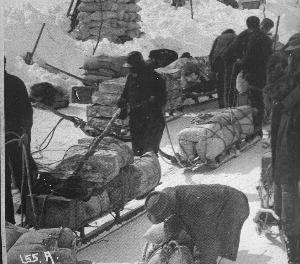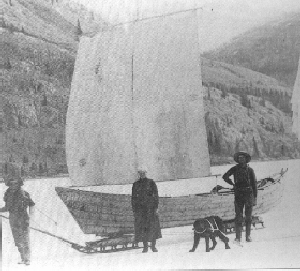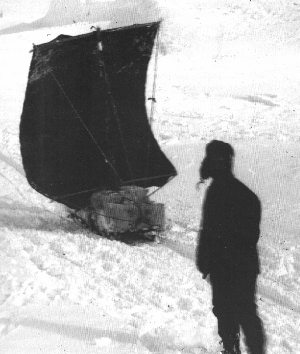
Sleds in the late 19th century were made of strong wood. This practice continues today although some sled builders are experimenting with other, more modern materials like fiberglass, UHMW plastic, and aluminum. Generally ash, birch or hickory is used. Birch is one of the most common woods in Alaska and the Northland so many sleds that were made up here are birch. Ash is a bit stronger and hickory is the strongest of all, although it is considerably heavier. I recently broke an ash runner (snapped it like a match stick) and made new ones out of hickory. These are as strong as an ax handle (hickory is used for many tool handles including axes as well as baseball bats).
The key with any sled is that it must be both strong and flexible. If it is too stiff, you cannot "drive" it. A sled is turned by two things, first, the dogs pulling it along from in front, and second by the driver (musher) leaning to the side and pushing the driving bow in the direction they want the sled to turn.
Sleds varied in length from fairly short ones with runners about six feet long to long, heavy freighting sleds with runners over fourteen feet long (like the one I restored). Sleds can carry a wide range of weight. The freight sleds could carry literally hundreds of pounds. I have even heard of references to them carrying over a thousand pounds!
Several years ago I had the pleasure of taking on the challenge of restoring an old freight sled. The color photographs I've included here are of that sled. It took almost a week of hard work because I chose to use hand tools to accomplish the job - no Tim "The Tool Man" Allen routines here. It took three days just to wrap and tie all of the rawhide lashings.
A sled is made of a number of parts. Traditional sleds (like those used in the gold rush) are today called "basket sleds" because they resemble baskets. Beginning at the snow level, I'll try and describe one.

Runners: The runners are a single piece of birch, ash or hickory measuring anywhere from six to fourteen feet in length. They generally average eight to ten. They are between 1 1/2 and 2 inches wide and about an inch thick.
Most runners have two layers of wood making them 1 1/2 to 2 inches thick. The front of the runner is bent to allow it to slide over the snow and get over objects (trees, rocks, bumps -- one day I was actually run over by my own sled, but that's a different story ...).
The bottom of the runners have what is called a "shoe", historically made of sheet iron or steel, today we use UHMW (ultra-high molecular weight) plastic similar to what you find on the bottom of skis and snow boards. This protects the bottom of the runner from rocks and abrasions that might weaken them.
Stanchions: The stanchions are the vertical pieces rising up from the runners. The number of stanchions varies depending on the length of the sled. Generally the rear most stanchion is about 2 to 2 1/2 feet forward of the runner's tail. Some sleds have a curved piece over the top of the two rear stanchions that is called the "driving bow". This is what the dog driver holds on to and uses to 'drive' the sled.
On freight sleds, there are a pair of "handle bars" similar to the handles on a wheel barrow only much shorter that are used to hold on to and guide the sled.
Top Rails: Along the top of the stanchions are long curved pieces of wood called the top rails. These provide support to hold the stanchions vertical and also help to support the load in the sled. On some sleds the top rails are joined at the back with the driving bow rather than having it a part of the rear stanchions.
Brush Bow: At the front of the sled, generally attached to the front stanchion (and sometimes to the second stanchion back) and the upper part of the runners is a long curved piece of wood (sometimes sheet iron, sometimes wood wrapped in rawhide - today generally plastic) called a brush bow. This basically serves as the bumper of the sled. It keeps it from snagging on trees, bushes, rocks, etc.
You can tell how bad a trail is by looking for gouges in the tree bark at about a foot or two above the snow line where sleds have smacked them -- I've left plenty of marks on trails!
Bed Slats or Sled Bottom: Approximately six inches above the snow are cross pieces between the stanchions. These support the bed slats which in turn carry the load of the sled. These run from the rear stanchions forward to the front stanchion so they vary in length depending on the length of the runners. They are usually about 1/4 to 1/2 inch thick and about 2 inches wide.
All of the wooden pieces are joined together using mortise and tenon joints. The pieces are held together using rawhide that has been soaked in water to make it pliable and to allow it to stretch. As it dries it shrinks and pulls the joints tightly together yet they still flex. The rawhide and sled are then varnished to protect them. Today's sleds are tied using nylon.
Historically the rawhide used came from moose hide. The Athabascan (one of the Native Alaskan groups living in the interior, particularly the upper Yukon River area) word for it is "babiche" (baa-bee-sh). One problem with using rawhide is that animals like to chew on it. A musher had to be careful that his dogs did not start chewing on it and when the sled was stored during the summer that small animals and rodents did not get to it. In the fall sleds generally had to be repaired where the lashings had either cracked and broken or were chewed off.
Brake: The brake on a sled consists of a metal "claw" on the end of a long length of wood that is hinged at it's upper end (near the middle of the sled). It is held up by a spring attached between the rear stanchions. A musher steps down on the brake to engage it.
To hold a sled in place, a musher would generally have one or two "snow hooks" that serve pretty much like anchors. They are attached to the end of the gangline (the main line the dogs are attached to) and are pushed into the snow. Sometimes it is necessary to use a snow hook to slow down the sled by dragging it in your hand. This is probably the most dangerous thing on a sled because it has two sharp points that tend to stand upwards as it bounces along the trail if it is dropped.
During the gold rush, the Northern Commercial Company (NC Co.) developed a mass-produced sled that was sold to men and women heading north. It was similar to the basket sled I described above, except that the stanchions were cut off at the bed slats. There are no driving bows or brush bows on it. It was similar to the old American Flyer sleds that kids use these days. Instead of being held together with babiche, they were actually bolted together. Again, these were a mass-produced sled that could be assembled with a minimum amount of time.

In spite of the number of these sleds made, there are only a few examples left today. One is in a museum in Fairbanks called the "Dog Mushing Museum." You will probably see examples of this type of sled in many of the photographs of people during the gold rushes.
The big difference between a basket sled and an NC sled is that the basket sled could carry a lot more weight. Although some argonauts found ways to carry very unusual loads on sleds. Again, it was just a matter of using your head to conquer problems that faced you.

When it comes to the number of dogs used to pull a sled, many people today are under the misconception that mushers used large teams (ten or more dogs). In reality most of them used no more than six and more times than not they only had between one and four dogs. They were however very big, strong dogs. The dogs that people see on the Iditarod for example are small, about 50 pounds for a big one. Trap line and freighting dogs will easily be over 100 pounds. Most of my team weight at least 75 pounds and several are pushing the 100 pound mark.
During the gold rush, dogs were an expensive commodity. Not only to buy them in the first place, but to feed them throughout the summer when they basically were not working. As a result, many Klondikers pulled their own sleds, guiding them with a "gee pole" attached to the front of the sled.

Although the smaller dogs are a generally a lot faster over a short distance, the heavier dogs can pull a lot more weight and cover many more miles in a single day. Also, a smaller dog team (fewer dogs) is a lot easier to control on a trap line or working your way through the woods. Large teams need a lot of room to turn, etc. Next time you're on the road, take a look at how much room it takes to turn a regular sized pickup versus how much a semi-truck needs to make the same team. Another practicality of having fewer dogs is that you don't have as many mouths to feed. When working hard on a trail, dogs can consume as much as 5000 to 8000 calories of food a day. Can you imagine if you ate that much!
It was also not uncommon to find people being ingenius in how they traveled from place to place. By rigging a sail to the sled, they were able to harness Mother Nature to do some of their work for them.

Believe it or not, a good way to see sleds in action is to watch the movies "Iron Will" and "White Fang", both by Disney. "Iron Will" shows a variety of sleds used in the race. The one Will uses is a light racing type sled, but the other mushers are using heavy freight sleds. The two Natives are using sleds with handle bars while some of the others are using sleds with driving bows. You will also notice the variety in styles. Each sled was an individual. Except for the NC sleds I described because they were made in a factory and mass-produced. "White Fang" gives a good idea of sleds and teams being used to haul freight as well.
I hope this information and these photos help! I think I'll have to re-work this and make it a permanent part of my website. Thanks for the great idea of doing this!
Keep smiling and mush on!!!